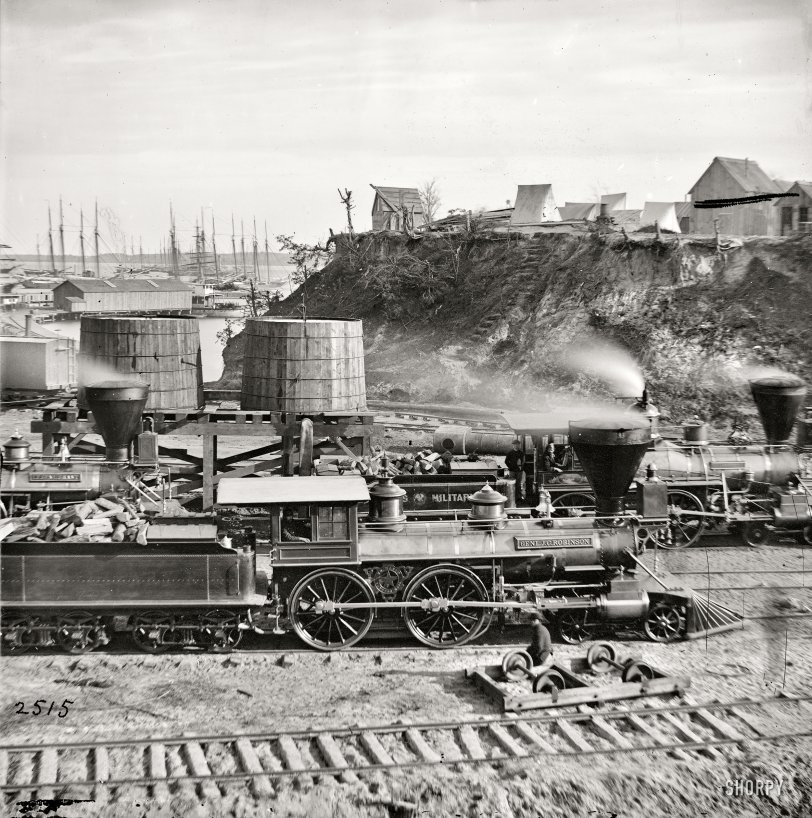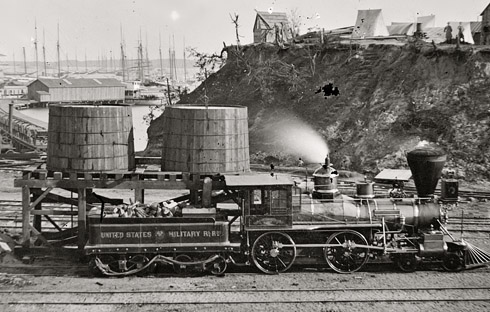


Framed or unframed, desk size to sofa size, printed by us in Arizona and Alabama since 2007. Explore now.
Shorpy is funded by you. Patreon contributors get an ad-free experience.
Learn more.

- Lofty addition
- In 1912
- Keenan Building
- Six years old
- Taken from the P.J. McArdle Roadway?
- It stood only 47 years
- Three track mind
- Incline to the right
- Reach for the sky, 1912 style
- No clean sweep
- Same Job Title, Same Face
- Sadly Lost
- Beautiful ...
- Where you get your kicks
- Aim High
- Pueblo Revival sisters
- Pueblo Neoclassicism
- Milk Man
- Regional dialect.
- Spielberg's inspiration
- Great Photo
- Loaf Story
- Do you still have the Rakes category?
- Could almost be a scene from the 1957 movie 'Hell Drivers'
- The Wages of Fear.
- Conspicuous by their absence
- Got Milk?
- All that aluminum
- No lefties
- Smoke 'em if you've got 'em
Print Emporium
Military R.R.: 1865

City Point, Virginia, circa 1865. "Gen. J.C. Robinson" and other locomotives of the U.S. Military Railroad. From views of the main Eastern theater of war, the siege of Petersburg, June 1864-April 1865. Wet plate glass negative. View full size.
O Scale model Civil War model railroad
Bernie Kempenski is building a model railroad with these kinds of locomotives, etc. His is dated 1862. http://usmrr.blogspot.com
Monitor identity
The monitor noted by others is most likely a Passaic-class ship and probably the Lehigh. The primary assumption is that the ship is perpendicular to the line of sight (as are the other ships). In that case comparing the monitor's funnel (tall thin light-colored tube to the left of the turret) to the turret, they are signifiicantly closer spaced than would be the funnel-turret distance for a Canonicus-class ship, the only other type which fits what is visible. This marks it as a Passaic. To identify it as the Lehigh is the stretch. At least three Passaics were known to have been in the City Point area at this time; the Lehigh, Patapsco, and Sangamon. The Patapsco and Sangamon were both confusingly identified as having a white ring at the top of the turret/base of the rifle shield. There is no ring visible on the turret of this monitor. The Lehigh was all black.
Bridge Of Beanpoples & Cornstalks
General J.C. Robinson 4-4-0 (Construction # 124) Formerly known as the USMRR locomotive General Haupt and acquired new by USMRR on January 17, 1863. Renamed General J.C. Robinson. Sold to the Baltimore & Ohio Railroad in 1865.
http://www.nvcc.edu/home/csiegel/USMRR%20Locomotives.htm
"That Man Haupt has built a bridge over Potomac Creek, about 400 feet long and nearly 100 feet high, over which loaded trains are running every hour, and upon my word gentlemen, there is nothing in it but beanpoles and cornstalks."
The Third Locomotive
The locomotive moving forward between the "Lt. Genl. Grant" and the "Genl. J.C. Robinson" is the "Governor Nye." This 4-4-0 was built by the Richard Norris & Son locomotive works in Philadelphia, and was acquired new by the USMRR on February 18, 1863. Sent to North Carolina in 1865 to work on the USMRR, it was still in the USMRR inventory in April 1866. Another photo taken within minutes of this one shows it in the yard.
Watch that last step...
I don't think that cliff-side staircase meets any imaginable safety regulation.
25 years of progress
It amazes me to think that these beautifully turned out engines are only one generation away from the dawn of American railroading (think Tom Thumb and iron-plated wooden tracks). A person born in 1820 grew up with horse, foot or canal-boat travel, when 50 miles was a good day's journey. During their adult years, they saw the rise of well-established railroads that could travel fifty miles per hour. This, together with the telegraph, was the dawn of the "shrinking world."
Oops
How did I not see that? Boy, is that embarrassing.
Interesting
Almost as interesting as the locomotives are the view of the ships in the harbor.
Buster Isn't There
I'll bet he is out visiting Annabelle Lee.
Hillside erosion
Attention troopers!
Gen. Grant has authorized the issuing of hazard pay due to the hillside erosion and the location of the outhouse.
It is further recommended that only those soldiers who know how to swim should make use of the facilitiesafter dark.
Spectre-vision
Nifty ghost in front of main tent!
Poor Lighting
Amazing that all the headlights on these locomotives were a kerosene lamp in a box with a magnifying lens.
Ironclad
In regard to the comment by Excel08 about the ironclad. Also according to Mr. Frassanito there would be about 200 vessels anchored off of City Point on any given day by the fall of 1864 including the ironclad ram "Atlanta" with one stack.
Grant and Lee
There is a photo so similar to this one in the book "Grant and Lee" by William A. Frassanito that it must have been taken about the same time. It is in the City Point chapter view 8. The tents and buildings on top of the bluff were part of the Railroad Hospital. The wharf shown is a replacement for one that was blown up by saboteurs on August 9,1864. The explosion killed 43 laborers and according to Mr. Frassanito narrowly missed General Grant who was in front of his headquarters tent at the time. His books have photos taken during the Civil War and then the same scene in modern times.
Union Ironclad
A turret of a Union ironclad can be seen in the background over the top of the pier-side warehouse. This could be the USS Onondaga, which was stationed at City Point to prevent Confederate ironclads from breaking out of the James River and attacking the supply base. The problem is that the USS Onondaga had two turrets and I only see one.
Grant's Iron Horse
Saturday we saw Grant's horse "Cincinnati;" today we see Grant's Iron Horse, "Lt. Genl. Grant," on the left.
A bigger name
Hard for me to see, but appears to be "Lt Gen. US Grant" on loco behind the Robinson machine. I am amazed at the hillside, ships and living conditions of the period.
Any idea
what the black things are in the upper right hand portion of the picture? When I looked at the blown up picture it looked a little bit like a lot of black socks hanging on a clothesline but that's obviously incorrect.
[It's a scratch in the emulsion. - Dave]
Location
The terrain and the enormity of the facilities in place makes me almost certain that this was taken at City Point, Virginia, the Union's main supply depot for the area at the time.
[Another clue would be the first three words of the caption. - Dave]
Robinson ahead by a nose
Seems that the Lt. Genl. Grant is running a close second. The named locomotives are from the Wm. Mason Machine Works in Taunton, Mass. The engine ahead of both seems unnamed. Might be an "American" locomotive or a Wm. Mason.
Who's Driving
The engineer is definitely not Buster Keaton.

























On Shorpy:
Today’s Top 5